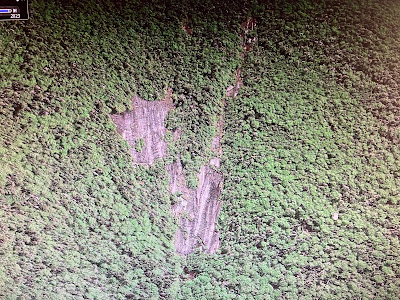A bushwhack exploration of a uniquely-shaped slide on the north side of Peak Above the Nubble, a northern spur of North Twin Mountain that is one of New England's Hundred Highest peaks. The trek also included a visit to the Nubble, a striking little rock peak that is accessed by an unofficial path.
This Google Earth image reveals why the slide received its name. It is prominent from several points along US Route 3 as it passes through the village of Twin Mountain.
The unofficial path to the Nubble starts off along a snowmobile trail.
The footpath portion leads through some nice hardwood forest, bright with early fall color.
The west branch of Haystack Brook is crossed at a small flume.
The ascent up the back side of the Nubble (2712 ft.), aka Haystack Mountain, is short but features several rock scrambles. This spot has a bit of exposure and might be uncomfortable for those who have a fear of heights.
The Nubble is an open rock perch with views west (shown here), south and east. Viewing distance was severely limited this day by Canadian wildfire smoke haze.
Mount Garfield and Mount Lafayette.
To the east there is usually a good view of the Presidentials but they were smothered in the haze this day.
Peak Above the Nubble rises close by to the SE. The large slab of the upper east fork of the Checkmark Slide can be seen at top center.
As expected, the big ledge slab looked shiny and wet.
Going back down that sketchy scramble.
More scrambling below.
A 2019 blog report from John "1HappyHiker" Compton noted that mostly open woods were encountered on an approach to the Checkmark Slide, and that certainly proved to be the case on this ramble.
Bushwhacking doesn't get much better than this.
Birch gold illuminated the forest.
As I got closer to the slide, the terrain got rougher, and I was happy to pick up an ancient logging road that John had followed on his trip to the slide.
Light at the end of the tunnel - there's the slide up ahead!
I figured that this slide would be too wet and slippery to safely climb, and when I reached the base that was confirmed.
The lower pitch of the slide is very steep.
Looking up from the base.
No one in their right mind would try to climb this slide in its current state of wetness, with plenty of greasy dark moss on top.
My previous experience with this slide was completely different. In April 1989 Mike Dickerman and I ascended Peak Above the Nubble. On the descent I mis-navigated our route down a ridge, and we ended up at the top of the Checkmark Slide. As luck would have it, the slide was cloaked in firm spring snow, ideal for kicking steps down it, thus avoiding a long, steep stretch in dense woods. (Photo by Mike Dickerman)
When a slide is unclimbable, you have to take to the usually steep and dense woods alongside it. I navigated a safe crossing at the base of the slide and headed up the east side.
I popped out at the edge for a side view of the lower of the two huge slabs.
First views out to the north. On a clear day the vista would take in many mountains in Vermont's Northeast Kingdom and the northern Green Mountains.
A view higher up along this slab.
A patch of Whorled Wood Aster, gone to seed, on a revegetated part of the slide track. This is one of the most common slide colonizers, found on 19 of 22 White Mountain slides surveyed by researcher Edward Flaccus in the 1950s.
After another climb through the woods, I emerged at the base of the massive slab that forms the upper eastern fork of the slide. This is the slab that is visible from the Nubble.
A little farther up there was a view back down to the Nubble.
It's a remarkable little rock protrusion.
Side view of the upper slab.
Looking up to the top of the slide.
The view from a perch I found at the edge of the upper slab. Nice spot for a long lunch break.
Type 2 fun as I continued up and around to the top of the slide.
Emerging from a tangle.
View from the top.
Heading back down the slope through the woods.
Back at the base of the slide.
Before heading out I went a short way up along the western side of the lower slab for a different angle looking up and across to the upper east slab.
Not many White Mountain slides have such wide expanses of bedrock, in this case syenite, a coarse-grained igneous rock. If it were dry it might provide good climbing. In its current wet and mossy state it is impressive to see, but is not recommended as a route to ascend Peak Above the Nubble!!









































No comments:
Post a Comment